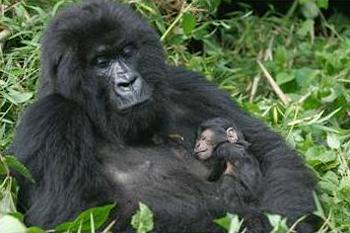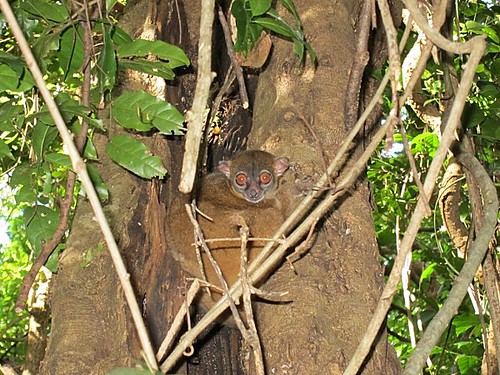來自160個國家代表在印度海德拉巴舉行召開《生物多樣性公約》第11次締約方大會,討論全世界物種在氣候變遷、棲地破壞、狩獵、盜獵等人類活動壓力下的共同未來。會中野生動物專家警告:世界過半種類的大型靈長類、猿猴及狐猴(人類在地球上的近親)瀕臨絕種,需要立即性的保育措施。
這份在海德拉巴發表的新報告中名為《身處險境的靈長類:25種瀕臨滅絕的靈長類,2012-2014》,由世界自然保育聯盟(IUCN)物種存續委員會靈長類小組及國際靈長類學彙編,國際保育協會及布裡斯托爾保育與科學基金會(Bristol Conservation and Science Foundation, BCSF)協同完成。
這份報告每兩年公布一次,揭露瀕臨滅絕的物種名單。
在本次的25種靈長類名單中,馬達加斯加有6種居冠、越南5種次之、印尼3種、巴西2種;中國、哥倫比亞、象牙海岸、剛果民主共和國,厄瓜多爾、赤道幾內亞、加納、肯亞、秘魯、斯里蘭卡、坦尚尼亞和委內瑞拉境內各有1種。
透過這份報告,保育人士期待傳達物種現況。以印尼蘇拉維西島中部及南部的侏儒眼鏡猴為例,在2008年前,這個物種僅以博物館內的三件標本為人所知;2008年在Lore Lindu National Park內捕獲了3隻個體、並紀錄到另一隻野外個體。這些剩下的零星族群受到人類入侵及武裝衝突的威脅。
馬達加斯加的狐猴面臨棲地喪失及非法狩獵的處境, 2009年馬達加斯加的政權更迭讓情況更加惡化。北方鼬狐猴目前在野外的數量剩下19隻。
今年7月,IUCN的物種存續委員會靈長類小組舉辦一場關於狐猴紅皮書的研討會,揭露103種現存種中的91%都面臨威脅及滅絕的處境。這是脊椎動物單一分類下有史以來的最高紀錄。
這份25種瀕臨滅絕的靈長類名單,為根據野外工作的靈長類學者對這些動物面臨的威脅的第一手知識所編撰。
布裡斯托爾保育與科學基金會領導人Christoph Schwitzer博士表示,「這份名單再一次顯現靈長類活在人類活動與日遽增的威脅下。雖然這個世紀我們還沒宣告任何一種靈長類滅絕,不過有些靈長類的確處境艱難。」
他說,「尤其是馬達加斯加的狐猴,歷經三年的政治動盪及缺乏有效的執法行動後,已經成為哺乳動物最瀕危的一個類群。東南亞因為野生動物的貿易,也使得許多靈長類面臨類似的情況。」
全世界633種靈長類,有54%被歸類於世界自然保育聯盟瀕危物種紅皮書的瀕絕名單內。他們面臨的主要威脅為棲地破壞─尤其是焚燒或清除熱帶森林使得他們無法覓食,以及非法野生動物貿易。
IUCN的物種存續委員會靈長類小組領導人Russell Mittermeier博士表示,「靈長類是人類的近親,也因為超過90%的靈長類居住在熱帶雨林,成為熱帶雨林最佳旗艦物種。」Mittermeier博士亦兼為國際保育協會總裁。
Mittermeier博士說,「令人驚訝的是,從2000年來我們每年持續發現新的靈長類。並且,靈長類持續成為生態旅遊的焦點、觀賞靈長類的熱潮持續增加,並為在地社區提供了主要生計來源。」
「瞭解靈長類在熱帶雨林扮演的關鍵角色是很重要的,作為協助種子傳播者來維護森林多樣性。現今人們越來越認知到森林生態系統服務的重大貢獻,提供人們飲用水,食品和藥品。」
儘管評估結果令人沮喪,保育學者呈現復育目標物種的成功案例。過去數十年的靈長類保育人士的努力下,20世紀沒有任何一種靈長類滅絕,且截至目前為止21世紀保持相同的紀錄,雖然有些種類非常接近滅絕。相較於其他脊椎動物類群的紀錄,這算是比較好的成果。
 數種靈長類由於現況改善,從第7版世界自然保育聯盟瀕危物種紅皮書中移除。包括印度的獅尾猴、一直名列於前六版紅皮書的馬達加斯加大竹狐猴由於外貌引起大眾興趣而改善處境不在列於前25種瀕危名單內。
數種靈長類由於現況改善,從第7版世界自然保育聯盟瀕危物種紅皮書中移除。包括印度的獅尾猴、一直名列於前六版紅皮書的馬達加斯加大竹狐猴由於外貌引起大眾興趣而改善處境不在列於前25種瀕危名單內。
該報告下載網址:
http://www.conservation.org/Documents/CI_Primates-in-Peril_25-Most-Endangered-Primates_2012-2014.pdf
More than half the world’s species of apes, monkeys and lemurs - humanity’s closest living relatives – are on the brink of extinction and in need of urgent conservation measures, wildlife experts warned today. The world’s 25 most endangered primates are named in a new report released at the UN’s Convention on Biological Diversity in Hyderabad.
Representatives of some 160 governments are meeting in Hyderabad to chart a future for all of Earth’s diverse species, which are under intensifying pressure from climate change, habitat destruction, hunting, poaching and other human activities.
“Primates in Peril: The World’s 25 Most Endangered Primates, 2012–2014″ was compiled by the Primate Specialist Group of IUCN’s Species Survival Commission and the International Primatological Society, in collaboration with Conservation International and the Bristol Conservation and Science Foundation.
Issued every two years, the report reveals those species most in danger of becoming extinct. Click here to see the list issued today.
Madagascar tops the list with six of the 25 most endangered species. Vietnam has five, Indonesia three, Brazil two, and China, Colombia, Côte d’Ivoire, the Democratic Republic of Congo, Ecuador, Equatorial Guinea, Ghana, Kenya, Peru, Sri Lanka, Tanzania and Venezuela each have one endangered primate within their borders.
With this report, conservationists want to publicize the situations of species such as the Pygmy Tarsier, Tarsius pumilus,of southern and central Sulawesi, one of Indonesia’s islands. This primate was only known from three museum specimens until 2008, when three individuals were captured inside the Lore Lindu National Park and one more was observed in the wild. The few remaining fragmented and isolated populations of this species are threatened by human encroachment and armed conflict.
Madagascar’s lemurs are threatened by habitat destruction and illegal hunting, which has accelerated since the change of power in the country in 2009. The rarest lemur, the Northern Sportive Lemur, Lepilemur septentrionalis, is now down to 19 known individuals in the wild.
A red-listing workshop on lemurs, held by the IUCN SSC Primate Specialist group in July, revealed that 91 percent of the 103 species and subspecies were threatened with extinction. This is one of the highest levels of threat ever recorded for a group of vertebrates.
The list of the world’s 25 most endangered primates has been drawn up by primatologists working in the field who have first-hand knowledge of the causes of threats to primates.
“Once again, this report shows that the world’s primates are under increasing threat from human activities. Whilst we haven’t lost any primate species yet during this century, some of them are in very dire straits,” says Dr. Christoph Schwitzer, head of research at the Bristol Conservation and Science Foundation.
“In particular the lemurs are now one of the world’s most endangered groups of mammals, after more than three years of political crisis and a lack of effective enforcement in their home country, Madagascar,” Dr. Schwitzer said. “A similar crisis is happening in Southeast Asia, where trade in wildlife is bringing many primates very close to extinction.”
Fifty-four percent of the world’s 633 primate species and subspecies with known conservation status are classified as threatened with extinction on the IUCN Red List of Threatened Species. The main threats are habitat destruction, particularly from the burning and clearing of tropical forests the hunting of primates for food, and the illegal wildlife trade.
“Primates are our closest living relatives and probably the best flagship species for tropical rain forests, since more than 90 percent of all known primates occur in this endangered biome,” says Dr. Russell Mittermeier, who chairs the IUCN SSC Primate Specialist Group and also serves as president of Conservation International.
“Amazingly, we continue to discover new species every year since 2000,” Dr. Mittermeier said. “What is more, primates are increasingly becoming a major ecotourism attraction, and primate-watching is growing in interest and serving as a key source of livelihood in many local communities living around protected areas in which these species occur.”
“It’s also important to note that primates are a key element in their tropical forest homes,” said Dr. Mittermeier. “They often serve as seed dispersers and help to maintain forest diversity. It is increasingly being recognized that forests make a major contribution in terms of ecosystem services for people, providing drinking water, food and medicines.”
Despite the gloomy assessment, conservationists point to the success in helping targeted species recover. Due largely to the efforts of dedicated primate conservationists, and underpinned by considerable public and media interest in the plight of our closest relatives, the world has not lost a single primate species to extinction in the 20th century, and no primate had yet to be declared extinct in the 21st century either, although some are very close to total extirpation.
This is a better record than for most other groups of larger vertebrates that have lost at least one, often more, species.
Several species have been removed from the IUCN Red list, now in its seventh edition, because of improved status, among them India’s Lion-Tailed Macaque,Macaca silenus, and Madagascar’s Greater Bamboo Lemur, Prolemur simus, which appeared on the first six lists, but has now been taken off thanks to the great increase of interest generated by its appearance as a top 25 species.
※ 全文及圖片詳見:ENS









